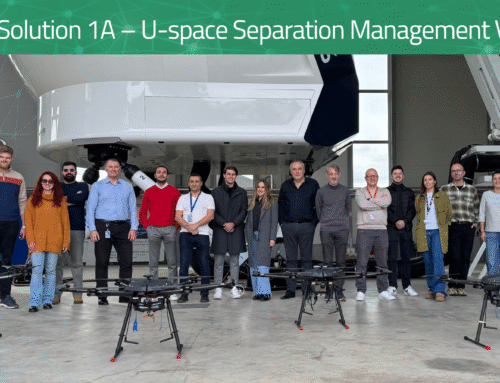On April 11, 2025, the SPATIO project held a virtual workshop that brought together project partners and Unmanned Aircraft System (UAS) operators to define critical elements of the U-plan authorization process. The session, chaired by Ángel Martínez from CRIDA, aimed to ensure a safe and efficient use of airspace in the context of U-space implementation.
Key Presentations
U-Space Separation Management
Pablo Sánchez presented the latest progress in the SPATIO project, focusing on separation services for UAS. His presentation outlined four proposed solutions: Strategic conflict resolution (SOL1A), Dynamic capacity management (SOL1B), and Tactical conflict prediction and resolution (SOL2A and SOL2B).
These services form the backbone of SPATIO’s approach to managing UAS operations in increasingly complex airspace.
Historical Context of RTTA
Andrew Hately from EUROCONTROL provided an overview of the origins of Real-Time Traffic Assessment (RTTA), tracing its conceptual roots to capacity management strategies used in manned aviation. He emphasized the importance of designing realistic and transparent timelines that balance airspace demand and capacity under U-space conditions.
Flight Plan Authorization in the Spanish Cluster
Rodrigo Benedit from ENAIRE, leader of the Spanish Cluster in the U-ELCOME project, showcased developments within the Spanish regional cluster of SPATIO, which includes eight participating regions. His presentation detailed a harmonized sequence for U-plan (flight plan) state transitions and illustrated the approach using practical use cases based on four-dimensional (4D) trajectory planning.
Workshop Outcomes
Participants contributed to an initial questionnaire designed to capture operator feedback regarding preferred U-plan submission timelines and the perceived importance of transparent and equitable authorization procedures.
A central outcome of the workshop was SPATIO’s proposal to implement an authorization cycle that delays final decisions until Demand and Capacity Balancing (DCB) is completed. This approach is intended to ensure fairness across all airspace users and make better use of available capacity.
Different RTTx timeline scenarios were presented to illustrate possible pathways for U-plan submission, evaluation, and approval:
-
Scenario 1: No conflicts
-
Scenario 2: Conflicts requiring resolution
-
Scenario 3: Situations involving dynamic capacity challenges
Further discussions are planned to refine and validate these proposed timelines.
Looking Ahead
Discussions also emphasized the importance of providing real-time feedback to UAS operators and moving away from a “first come, first served” approach. Instead, the adoption of a priority-based queuing system is being considered to better align authorization decisions with strategic airspace management goals.
The SPATIO consortium will continue to develop and test these concepts in collaboration with stakeholders, ensuring that the emerging U-space framework supports safe, fair, and scalable drone operations.





